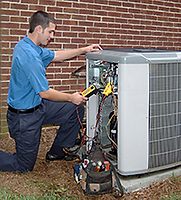Agreement sets stage for new SEER ratings for AC and heat pumps

The efficiency level for residential central ACs under 45,000 Btu/hr would be 14 SEER in the North, and 15 SEER in the Southeast and Southwest; for products over 45,000 Btu/hr, the levels would be 14.5 SEER in the Southeast and Southwest, and 14 SEER in the North. HP efficiency levels would be set at 15 SEER for all regions.
An agreement reached among industry and environmental stakeholder groups to increase the energy efficiency of central cooling systems passed an important milestone today in advance of the U.S. Department of Energy developing a new energy-saving standard that could save consumers $38 billion.
The Appliance Standards and Rulemaking Federal Advisory Committee approved an agreement for recommendations on a new standard for residential central air conditioning and heat pump efficiency levels that was developed by a DOE-formed working group.
In the United States, about 60 percent of households have a central cooling system and about 19 percent of those systems are HPs. Virtually all new homes are built with central AC.
Andrew deLaski, executive director of the Appliance Standards Awareness Project and ASRAC's representative on the WG, said, "The energy and bill savings from the recommended new central AC and HP standards will really add up for consumers and the nation. Savings will reach about 300 billion kilowatt-hours on sales over 30 years (enough to cool 150 million average homes for a year) and $38 billion in bill savings.
"We are pleased see that yet again, industry and environmental leaders have been able to come together and reach an agreement that will benefit consumers, businesses, and employees for years to come," said AHRI president and CEO Stephen Yurek, another participating company in the WG. "We have always believed that the negotiated rulemaking process is the best way to establish workable, effective regulations, and this agreement once again proves that to be true."
The agreement is the latest in a string of successfully negotiated energy efficiency standards completed by a diverse group of stakeholders, including manufacturers, utility companies, efficiency advocates, state government representatives, contractors, distributors, and DOE itself. Other recent examples include commercial rooftop ACs and furnaces, and walk-in coolers and freezers.
The proposal for improved AC and HP efficiency builds on previous consensus standards issued in 2011 that took effect last year and, before that, the very large improvements that took effect in 2006. Combined, these three rounds of improvements (effective in 2006, 2015, and now 2023) will raise central AC and HP efficiency by about 50 percent over a span of less than 20 years.
"The latest update to the standards shows that sustained rates of improvement are possible even with products that have already seen major efficiency upgrades," stated Steven Nadel, executive director of the American Council for an Energy-Efficient Economy.
"Today's agreement is a big win for consumers and the environment, as well as for manufacturers, who get long-term regulatory certainty," said Meg Waltner, manager for building energy policy at the Natural Resources Defense Council. "The new standards will add to the long history of savings for these products, resulting in billions of dollars of consumer savings, while reducing electricity use and the harmful pollution associated with it. It's a win all around."
Once approved by DOE, the energy efficiency levels agreed to in the negotiations will go into effect Jan. 1, 2023, but will be adjusted based on changes to product test procedures. Under the agreement (and using current test procedures), the efficiency level for residential central ACs under 45,000 Btu/hr would be 14 SEER in the North, and 15 SEER in the Southeast and Southwest; for products over 45,000 Btu/hr, the levels would be 14.5 SEER in the Southeast and Southwest, and 14 SEER in the North. HP efficiency levels would be set at 15 SEER for all regions.




